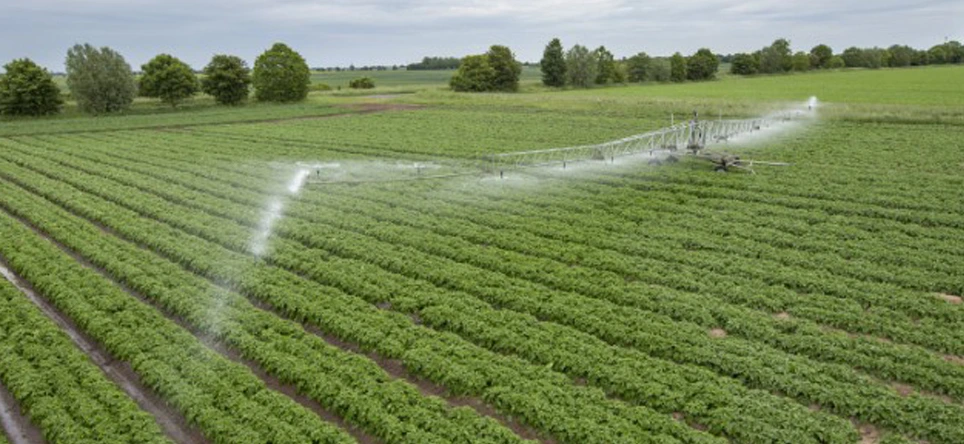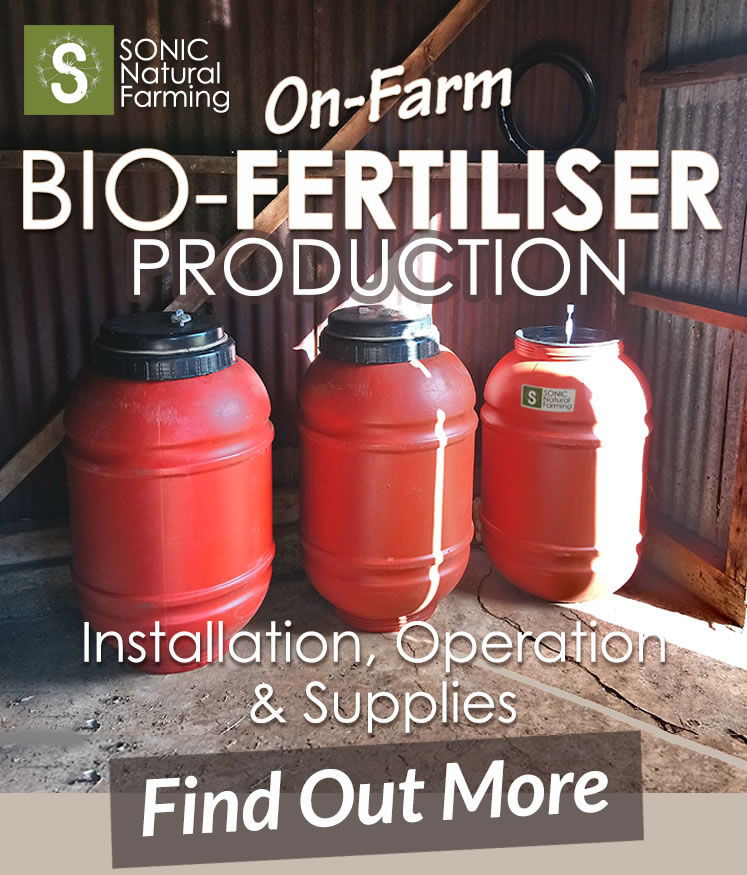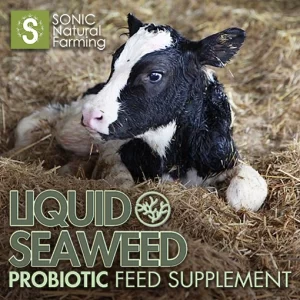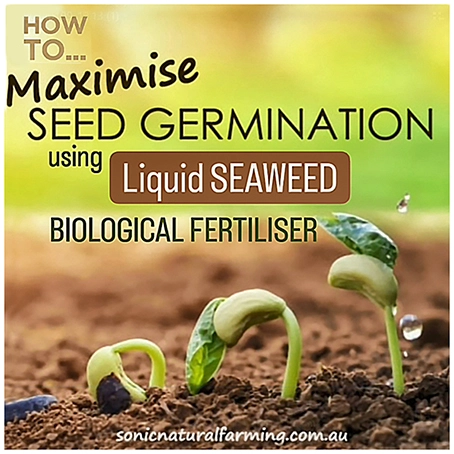Effective agricultural water management is crucial for sustaining productivity and ensuring the long-term viability of farming operations. In Australia, where water scarcity and unpredictable climate conditions pose significant challenges, implementing efficient water management strategies can make a substantial difference.
This article will explore the top 10 strategies for effective water management on your farm, including innovative methods such as drip and sprinkler irrigation, land contours, planting riparian buffers, and using cover crops.
We’ll also discuss the benefits of conservation tillage, rotational grazing, nutrient management, water monitoring systems, maximising water quality, and using organic fertilisers. These strategies not only help in conserving water, and saving money, but can also enhance soil health and crop productivity.

1. Rainwater Harvesting Systems
Efficiently harvesting rainwater on-farm is an excellent water management strategy that offers numerous environmental, economic, and agricultural benefits.
By implementing a well-designed system, farmers can significantly reduce their reliance on external water sources, improve water conservation, and ensure a more sustainable farming operation. This strategy, when combined with other water-saving techniques, can play a crucial role in addressing water scarcity and enhancing farm productivity.
Benefits of Rainwater Harvesting on Farms
- Cost Savings: By using harvested rainwater for irrigation and other farm needs, farmers can reduce their reliance on costly municipal or groundwater sources. This is especially valuable in areas where water prices are rising or where access to water is limited.
- Sustainable Water Use: Rainwater harvesting helps promote sustainability by reducing the demand on local water systems and minimising environmental damage caused by over-extraction of groundwater or surface water.
- Drought Resilience: Storing rainwater during wet periods ensures that farmers have a reliable water supply during dry spells. This can be a crucial factor in maintaining crop production during times of low rainfall or drought.
- Improved Crop Yields: Consistent water availability for irrigation can lead to healthier crops and more reliable harvests, especially in regions where irrigation infrastructure is lacking or inefficient.
- Reduces Runoff and Erosion: Capturing rainwater helps to reduce surface runoff, which can cause soil erosion, flooding, and water contamination. By slowing the flow of water, it also helps retain moisture in the soil, benefiting crops.
Challenges of Implementing Rainwater Harvesting Systems
- Initial Investment: The installation of rainwater harvesting systems requires upfront costs for materials, storage tanks, and installation. However, these costs are often recouped over time through savings on water bills and improved crop yields.
- Quality Control: If not properly filtered, rainwater can carry contaminants from rooftops or storage tanks that may affect crop health or livestock. Regular maintenance and proper filtration are crucial for ensuring water quality.
- Variable Rainfall: In some regions, rainfall may be unpredictable or inconsistent, making it difficult to rely solely on rainwater. To overcome this, farmers may need to combine rainwater harvesting with other water-saving strategies, like drip irrigation or soil moisture management.

2. Land Contours
In agriculture, water management is crucial for maximising productivity while ensuring sustainability. Beyond rain water capture, land contours can be an effective tool for enhancing water management.
By strategically shaping the landscape, farmers can optimise water flow, improve drainage, and create natural reservoirs to capture and retain rainfall. This holistic approach helps ensure that the land works in harmony with the natural water cycle, improving water retention and reducing waste.
Benefits of Using Land Contours in Water Management
- Improved Water Retention: One of the primary advantages of land contours is their ability to slow down the flow of water. By shaping the land in strategic ways, water moves more slowly, allowing it to be absorbed by the soil instead of running off. This improves water retention in the soil, helping to reduce the need for additional irrigation during dry spells.
- Erosion Prevention: Water runoff, especially on slopes, can lead to significant soil erosion, washing away valuable topsoil. Land contours, such as terraces, act as barriers that slow water flow, reducing erosion. This allows farmers to maintain healthy soil for longer periods, enhancing soil fertility and preventing the loss of productive land.
- Targeted Water Flow: By designing land contours to direct water toward specific areas, such as crop fields or storage ponds, water use becomes more efficient. This targeted management ensures that water is directed to where it is needed most, particularly during dry periods, improving irrigation efficiency and ensuring that crops receive the moisture they need to thrive.
- Flood Control: Shaping the land to slow down water flow can also reduce the risk of flooding. The controlled movement of water across the farm prevents it from gathering in low-lying areas, thereby minimising the damage caused by sudden heavy rainfall and ensuring that water is used effectively instead of being lost.
- Replenishing Groundwater: Land contours can also facilitate the natural replenishment of groundwater. As water is absorbed into the soil, it has the opportunity to filter down into underground aquifers, improving the availability of groundwater for future use.
- Increased Agricultural Yields: When water is managed efficiently and soil is protected from erosion, crops receive more consistent moisture, leading to higher agricultural yields. The reduced need for external irrigation and the improved ability to cope with droughts help make farming practices more sustainable and resilient.
Challenges of Implementing Land Contours for Water Management
- Initial Investment and Labor: Shaping the land to create effective contours requires an upfront investment in both time and resources. The cost of designing and implementing these changes, including the labor needed to shape the land and install drainage systems, can be significant, particularly for larger farms.
- Maintenance Requirements: Land contours need regular maintenance to ensure that water flows as intended. Over time, erosion or shifts in the landscape may alter the effectiveness of the contours, requiring periodic adjustments and repairs to maintain their functionality.
- Complexity of Design: Designing effective land contours requires a deep understanding of the local topography and water flow patterns. Farmers may need professional guidance or specialised knowledge to ensure the contours are well-planned and executed. Improper design can lead to water mismanagement or ineffective drainage.
- Limited Effectiveness in Flat or Dry Areas: In areas with very flat terrain or in regions experiencing low rainfall, land contours may not provide as significant a benefit. Without the natural force of water flowing downhill, or enough rain to capture, the contours may have limited impact on water retention or irrigation.
- Long-Term Commitment: Land contouring is not a quick fix. It takes time for the soil and landscape to adapt, and it may take several seasons for the full benefits of water retention and erosion control to be realised. Farmers must be committed to long-term planning and patience for the strategy to succeed.
By strategically shaping the landscape, land contours can significantly improve water retention, reduce erosion, and enhance the overall efficiency of irrigation and drainage systems
At the Danthonia Bruderhof farm here in Australia – a land renowned for “drought and flooding rains” (and bushfires) – we’re implementing Regenerative Agriculture practices, to work with nature to restore and improve our landscape. (Above video).

3. Planting Riparian Buffers
As environmental concerns continue to grow, sustainable water management practices have become increasingly important. One such strategy gaining attention is the establishment of riparian buffers. These vegetated zones, consisting of trees, shrubs, and grasses planted along waterways, play a crucial role in improving water quality and conserving water resources. By addressing issues like nutrient runoff, sedimentation, and erosion, riparian buffers provide an eco-friendly solution to maintaining the health of freshwater systems.
Benefits of Planting Riparian Buffers
- Reduction in Nutrient Runoff and Pollution: Riparian buffers act as natural filters, trapping sediments, nutrients, and pollutants before they enter streams, rivers, or lakes, improving water quality.
- Enhanced Water Infiltration and Groundwater Recharge: The vegetation slows water flow, promoting infiltration and allowing water to filter down to recharge groundwater supplies.
- Flood and Drought Regulation: By regulating water flow, riparian buffers help mitigate the risks of both flooding and drought by stabilising water levels.
- Prevention of Erosion: Deep-rooted plants in riparian buffers stabilise streambanks, preventing soil erosion and protecting the integrity of aquatic ecosystems.
- Biodiversity Enhancement: Riparian buffers provide valuable habitats for wildlife, helping to increase biodiversity in agricultural areas.
- Aesthetic and Landscape Improvement: These vegetated areas can enhance the visual appeal of the landscape, adding to the overall beauty of farm environments.
- Cost-Effective Water Conservation: Investing in riparian buffers is a low-cost, ecologically sound approach to conserving water and improving environmental health in the long term.
Challenges of Planting Riparian Buffers
- Initial Setup and Maintenance: Establishing riparian buffers requires time, effort, and financial investment in planting and maintaining vegetation.
- Site-Specific Challenges: The effectiveness of riparian buffers can depend on local conditions such as soil type, water flow, and vegetation species. Incorrect plant selection or poor site design may limit their success.
- Competition for Land Use: In some cases, dedicating land along waterways to vegetation buffers may compete with other agricultural activities, making it harder for farmers to utilise all available land for crops or livestock.
- Long-Term Commitment: Riparian buffers take time to establish and show results. Farmers need to commit to long-term maintenance and management to ensure their success.
- Vulnerability to Extreme Weather: Severe storms or flooding can damage or disrupt the function of riparian buffers, requiring ongoing care and adaptation to changing weather patterns.
The deep-rooted vegetation of riparian buffers stabilises streambanks, preventing erosion and preserving the integrity of aquatic ecosystems

4. Cover Crops and Pasture Cropping
Cover cropping is a highly effective method for improving water conservation, water quality, and overall soil health on farms. By planting a mix of plant species, cover crops create a living mulch that protects the soil, enhances water infiltration, and reduces surface runoff. This sustainable practice not only conserves water but also ensures that the water that does reach streams and aquifers is of higher quality.
Benefits of Cover Crops and Pasture Cropping
- Improved Water Conservation: Cover crops help reduce the need for additional irrigation by improving water retention in the soil. Their root systems create channels for water to infiltrate deeper into the ground, ensuring the soil remains moist and reducing the need for frequent watering.
- Water Quality Enhancement: By preventing soil erosion and nutrient leaching, cover crops improve water quality. The dense foliage traps contaminants and slows water movement, allowing water to be filtered before it reaches nearby water sources, such as streams and aquifers.
- Erosion Prevention: The living root system of cover crops helps bind the soil, preventing erosion. This is particularly important in areas where heavy rainfall or wind can otherwise strip away topsoil, leading to the loss of valuable nutrients and soil structure.
- Pollutant Reduction: Cover crops act as a natural filter, keeping excess nutrients, such as nitrogen and phosphorus, and contaminants from leaching into groundwater supplies. This helps to protect both water quality and the long-term health of the soil.
- Increased Soil Fertility: Through pasture cropping or the use of nitrogen-fixing cover crops, farmers can naturally enhance soil fertility, reducing the need for synthetic fertilizers and improving overall soil health.
- Improved Water Infiltration: By slowing the flow of water and promoting infiltration, cover crops prevent surface runoff. This allows more water to be absorbed into the soil, replenishing groundwater supplies and reducing the risk of flooding.
Challenges of Cover Crops and Pasture Cropping
- Initial Investment: Establishing cover crops requires an upfront investment in seed, planting equipment, and potentially additional labour. Although the long-term benefits are significant, the initial setup can be a barrier for some farmers.
- Competition for Resources: In some cases, cover crops may compete for nutrients and moisture with main crops, especially in regions with limited rainfall. Careful planning is necessary to ensure that cover crops do not negatively impact the growth of primary crops.
- Management and Maintenance: While cover crops require relatively low maintenance, they still need to be monitored for diseases, pests, and proper growth. Farmers must also manage the termination of cover crops at the right time to ensure they don’t interfere with the planting or growth of main crops.
- Adaptation to Local Conditions: The effectiveness of cover crops can vary depending on local soil types, climate, and water availability. Farmers need to carefully select the right species of cover crops that will work best in their region and under their specific growing conditions.
- Timing Challenges: Planting and managing cover crops requires good timing to ensure they grow effectively during off-seasons without interfering with the main cropping cycle. This can be challenging for farmers with limited resources or time.
Cover crops not only helps conserve precious water resources, but also improves the quality of the water that does make it into nearby streams and aquifers
See also ‘Top 2 Most Cost-Effective Pasture and Cover Cropping Tips’
‘How to Increase Soil Fertility with Mixed-Species Planting’

5. Implementing Conservation Tillage
Conservation tillage is a farming practice that helps improve water conservation and water quality by reducing soil disturbance and leaving crop residues on the surface. This approach not only preserves soil structure but also helps reduce soil erosion and runoff, safeguarding valuable water resources.
Benefits of Implementing Conservation Tillage
- Improved Water Infiltration: By leaving crop residues on the soil surface and minimising disturbance, conservation tillage helps water infiltrate the soil more efficiently. This means that more water is absorbed and stored in the ground, reducing surface runoff.
- Reduction in Runoff: With less soil disturbance, conservation tillage helps prevent runoff, which can carry sediment, nutrients, and pollutants into nearby waterways. This results in cleaner, more sustainable water sources.
- Water Quality Protection: By reducing runoff and the movement of pollutants, conservation tillage helps maintain the purity of surface and groundwater supplies. This ensures a cleaner water supply for farm use and nearby ecosystems.
- Increased Soil Organic Matter: Conservation tillage enhances soil structure and increases organic matter, which in turn boosts the soil’s water-holding capacity. This helps plants access water more efficiently, reducing the need for additional irrigation.
- Reduced Irrigation Needs: By improving water retention in the soil, conservation tillage reduces the need for frequent irrigation, helping farmers conserve water while maintaining healthy crops.
- Erosion Prevention: By minimising soil disturbance and maintaining crop residues, conservation tillage helps prevent soil erosion, preserving the fertility and integrity of the land.
Challenges of Implementing Conservation Tillage
- Initial Transition Period: Switching to conservation tillage may require a transition period where farmers need to adjust to new practices and equipment. This may initially reduce yields as the system adapts to new farming methods.
- Increased Weed Pressure: Conservation tillage can sometimes lead to increased weed growth because the soil is disturbed less, making weed management more challenging. Farmers may need to adopt additional strategies such as cover cropping or integrated weed management.
- Equipment Requirements: Although conservation tillage reduces some tillage equipment use, it often requires specialised machinery to handle the residue left on the surface. This can be a significant upfront investment.
- Crop Residue Management: Maintaining adequate crop residues on the soil surface can be difficult in some areas, particularly if there are issues with residue decomposition or in regions with high wind or heavy rainfall.
- Adaptation to Local Conditions: The effectiveness of conservation tillage can vary depending on local soil types, climate conditions, and crop types. Farmers need to carefully evaluate their specific situation before fully adopting conservation tillage practices.
Conservation tillage helps maintain the purity of surface and groundwater supplies, ensuring a cleaner, more sustainable water source for your farm
Soilkee is a proprietary system developed to improve soil health and structure while reducing the need for traditional plowing. The Soilkee system works by using a specialised machine to aerate and mix soil without turning it over like conventional tillage methods.
Here’s why Soilkee is classified as conservation tillage:
Minimal Soil Disturbance: Unlike traditional plowing, which turns over the soil and can lead to erosion and degradation, Soilkee minimizes soil disturbance. This helps maintain soil structure and reduces the risk of erosion.
Improvement of Soil Health: The Soilkee system promotes soil aggregation, organic matter incorporation, and improves water infiltration—all key aspects of conservation tillage that contribute to long-term soil health.
Reduction of Soil Erosion: By avoiding deep plowing, Soilkee helps protect the topsoil and prevents the erosion that can occur with traditional tillage methods.
Moisture Retention: The system allows for better moisture retention in the soil, which is a benefit of no-till or minimal tillage practices.
Soilkee aligns with the principles of conservation tillage because it aims to reduce soil disturbance, promote soil health, and decrease erosion, all of which are core goals of conservation tillage systems.
What if Farm Soil Could Heal Itself? Farm Learning with Tim Thompson (Interview on Soilkee’s 7 year trial property).

6. Rotational Grazing
Rotational grazing is an effective strategy for preserving water quality, improving soil health, and maintaining ground moisture. By rotating livestock between different paddocks, farmers can reduce soil compaction and prevent overgrazing—two key factors that contribute to water pollution and soil degradation. This approach supports the overall health of the land and helps ensure a sustainable water supply.
Benefits of Rotational Grazing
- Prevention of Soil Compaction: Rotational grazing helps to avoid the continuous grazing of the same area, which can compact the soil. Compacted soil leads to poor water infiltration, increasing runoff and sedimentation in nearby waterways.
- Reduction in Erosion and Runoff: By allowing paddocks time to recover between grazing periods, rotational grazing prevents the trampling of vegetation. This reduces the risk of soil erosion and runoff, helping to maintain water quality in nearby streams and rivers.
- Improved Vegetation Regrowth: Resting pastures between grazing periods allows vegetation to regrow, maintaining ground cover that absorbs rainfall and prevents erosion. This promotes healthier, more resilient ecosystems.
- Water Retention and Moisture Preservation: Maintaining healthy vegetation and soil structure through rotational grazing helps preserve soil moisture. Well-covered land reduces evaporation and ensures that more water is available for crops and livestock.
- Enhanced Water Quality: By preventing overgrazing and soil degradation, rotational grazing helps prevent sedimentation and nutrient runoff into nearby water bodies. This keeps water sources cleaner and supports aquatic habitat quality.
- Sustainable Land Use: Rotational grazing provides a sustainable way to manage livestock while protecting the land’s long-term health. It supports both agricultural productivity and the broader watershed.
Challenges of Rotational Grazing
- Initial Setup and Planning: Implementing a rotational grazing system requires careful planning to design paddocks and establish grazing schedules. This may require new infrastructure, such as fencing or water sources in each paddock, which can involve upfront costs and labour.
- Labour and Time Management: Rotational grazing demands more time and attention from farmers to manage livestock movement and ensure that grazing periods are properly rotated. However, once the livestock are accustomed to the system and recognise that the grass is greener in the new paddock, they are often eager to move. While the farmer may need to open gates more frequently, the animals typically move willingly, reducing the need for herding or additional effort in moving them.
- Potential for Overgrazing in Recovery Periods: If paddocks are not given sufficient time to recover, there is a risk of overgrazing, which could negate the benefits of the system. Proper timing and monitoring are essential to ensure optimal recovery.
- Land Size and Configuration Limitations: Rotational grazing may be more challenging in smaller or irregularly shaped fields. Larger, more expansive properties are often better suited for this type of grazing system.
- Inconsistent Grazing Results: Depending on environmental conditions, such as drought or excessive rainfall, some paddocks may not recover as quickly, requiring adjustments to grazing schedules and management practices.
Rotational grazing gives the land time to recover between grazing periods, allowing the soil to retain its structure and the vegetation to regrow

Above video – shows how you can do a simple test on-farm to see the water retention capabilities in your soil.

Above image; Water Monitoring System from Gallagher


Reverse Osmosis water treatment unit from Vertex Hydropore, (Above image).

Disclaimer:
The information in this article is for general guidance and not professional advice—always consider your individual circumstances or consult with a professional before making decisions. For more details, please review our full Disclaimer.
At SONIC Natural Farming, we’re committed to helping Aussie farmers easily access organic inputs, at the same time as saving big!
SONIC On-Farm Production Services minimise transportation costs. Plus, by reusing storage containers on the farm, farmers can reduce plastic waste and packaging expenses, saving even more.
But that’s not all—SONIC Production and Training Programs empower farmers to produce their own Biological Solutions using the most eco-friendly and cost-effective supply option available in Australia today.

Want to see how we can help you beat the high cost of fertiliser?















